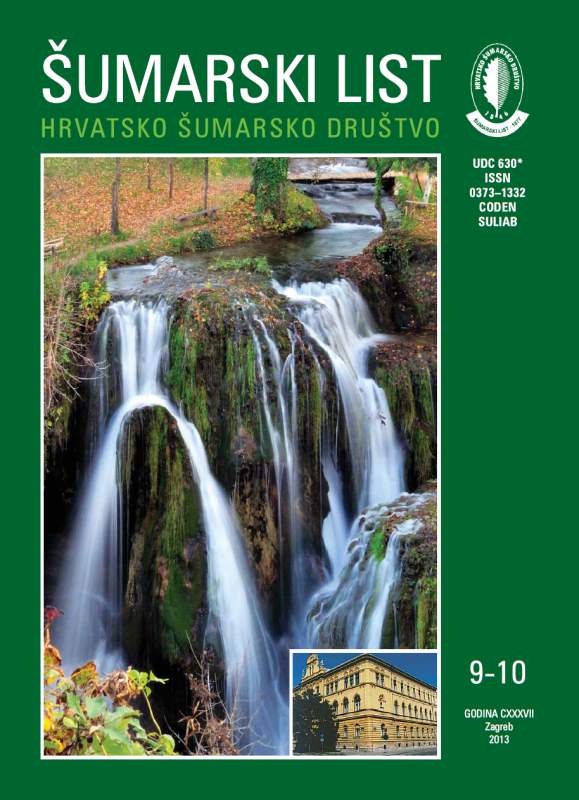
broj: 9-10/2013
pdf (8,91 MB) |
|
||||||||||||||
| RIJEČ UREDNIŠTVA | ||
| uredništvo | ||
| THE NEW EU FORESTRY STRATEGY: FOR FORESTS AND THE FOREST-BASED SECTOR pdf HR EN | 445 | |
| IZVORNI ZNANSTVENI ČLANCI | ||
| Damir DRVODELIĆ, Milan ORŠANIĆ, Sanja PERIĆ, Martina TIJARDOVIĆ | UDK 630*232.3+181.3 (001) | |
| INFLUENCE OF IRRIGATION AND MICRO-RELIEF IN NURSERIES ON MORPHOLOGICAL CHARACTERISTICS OF PEDUNCULATE (Quercus robur L.) AND SESSILE OAK (Quercus petraea L.) FOREST SEEDLINGS pdf HR EN | 447 | |
| Summary: We researched the influence of irrigation and micro-relief in nurseries on morphological properties of pedunculate and sessile oak seedlings (2+0). The test plots were established in the forest nursery Hajderovac, Forestry Office Kutjevo, Forest Administration Branch Požega. The sowing of sessile oak acorns was carried out from 7 to 11 October 2005, and of pedunculate oak on 14 October 2005. Irrigation was taken as a treatment for the pedunculate oak seedlings (1 non-irrigated, 2 irrigated) while for the sessile oak seedlings it was the micro-relief (1 on slopes, 2 on flat terrain). At the end of the second growing season a random sample of seedlings was taken from the test plots for a morphological analysis. The morphological analysis of the washed root system was performed on the scanner Epson Expression 10000XL while the WinRhizo pro.V.2005 software was used to determine five root variables: length (cm), perimeter (cm2), average diameter (mm), volume (cm3) and number of root tips (pieces). For the seedlings of pedunculate oak a variance difference higher than the set limit (p=0,05) was established for the following variables: root length (p=0,293703), root perimeter (p=0,21999), root volume (p=0,281090) and the number of root tips (p=0,829142). Mann Whitney’s U-test established a statistically significant difference in height (p=0,000000), root collar diameter (p=0,000284) and the average root diameter (p=0,011632) between the non-irrigated (1) and the irrigated (2) seedlings of pedunculate oak. With an average height of 578 mm (322–790 mm) the irrigated pedunculate oak seedlings (2+0) were by 305 mm higher compared to the non-irrigated ones. The average root collar diameter of the irrigated seedlings was also by 0,92 mm larger compared to the non-irrigated ones and amounted to 6,91 mm (4,93–9,90 mm). On average the root diameter of the irrigated seedlings was by 0,12 mm larger compared to the non-irrigated ones. The irrigated seedlings of pedunculate oak also showed a larger total root length (cm), root perimeter (cm2) and number of root tips (pcs) with respect to the non-irrigated ones but the mentioned characteristics are not significant. For the seedlings of sessile oak a variance difference higher than the set limit (p=0,05) was established for the following variables: height (p=0,178360), root collar diameter (p=0,077099) and root length (p=0,148820). Mann Whitney’s U-test established a statistically significant difference in all the four tested variables (root perimeter (p=0,000010), average root diameter (p=0,025060), root volume (p=0,000037) and number of root tips (p=0,000427) between the sessile oak seedlings on slopes (1) and on the flat terrain (2). The average root perimeter of the sessile oak seedlings grown on slopes was by 85,39 cm2 larger compared to the seedlings grown on flat terrain and amounted to 271,97 cm2 (58,57–633,94 cm2). The average root diameter of the sessile oak seedlings on slopes was 1,60 mm (1,17–2,10 mm) which is by 0,10 mm longer compared to those on flat terrain. The average root volume of the seedlings on slopes was by 3,88 cm3 larger compared to those on the flat terrain and amounted to 10,99 cm3 (2,40–27,21 cm3). The seedlings on slopes had 818 root tips (111–2551 pcs), which is 226 pieces more compared to those from flat terrain. The seedlings of sessile oak growing on slopes had larger height (mm), root collar diameter (mm) and the total root length (cm) with respect to those on flat terrain but the mentioned characteristics are not significant. The research proves that irrigation of pedunculate oak seedlings in nursery influenced several quality variables (height, root collar diameter). Therefore, irrigation should become a required practice for the seedlings on the entire nursery production area. On the other hand, the seedlings of sessile oak display an increase in several root quality variables (perimeter, average diameter, volume, number of tips) when grown on slopes, and this practice should be adopted in all nurseries with developed micro-relief. Key words: seedling quality; root length; root perimeter; root collar diameter; root volume; number of root tips | ||
| Roman ROSAVEC, Zoran ŠIKIĆ, Željko ŠPANJOL, Damir BARČIĆ, Marko VUČETIĆ | UDK 630*431 (Pinus halpensis Mill) (001) | |
| WILDFIRE THREATS WITHIN THE HABITAT CONDITIONS IN ALEPPO PINE STANDS (Pinus halepensis Mill.) OF ADRIATIC KARST AREA pdf HR EN | 461 | |
| Jelena Nedeljković, Marko Lovrić, Dragan Nonić, Makedonka Stojanovska, Vaska Nedanovska, Nataša Lovrić, Vladimir Stojanovski | UDK 630*899 (001) | |
| INFLUENCE OF POLICY INSTRUMENTS ON NON-WOOD FOREST PRODUCTS COMMERCIALIZATION IN CROATIA, MACEDONIA AND SERBIA pdf HR EN | 473 | |
| Osman MUJEZINOVIĆ, Josip MARGALETIĆ, Tarik TREŠTIĆ, Mirza DAUTBAŠIĆ | UDK 630*451+151 (001) | |
| THE IMPACT OF THE HABITAT TO THE PRESENCE OF BANK MOLE (Myodes glareolus) AND YELLOW-THROAT MOUSE (Apodemus falvicollis) IN THE AREA OF BOSNIA pdf HR EN | 487 | |
| PRETHODNO PRIOPĆENJE | ||
| Milivoj FRANJEVIĆ | UDK 630*453 | |
| BIVOLTINISM OF EUROPEAN HARDWOOD AMBROSIA BEETLE Trypodendron domesticum IN CROATIAN LOWLAND OAK STANDS OF JASTREBARSKI LUGOVI pdf HR EN | 495 | |
| Boris Hrašovec, Darko Posarić, Ivan Lukić, Milan Pernek | UDK 630*453 | |
| FIRST RECORD OF OAK LACE BUG (Corythucha arcuata) IN CROATIA pdf HR EN | 499 | |


